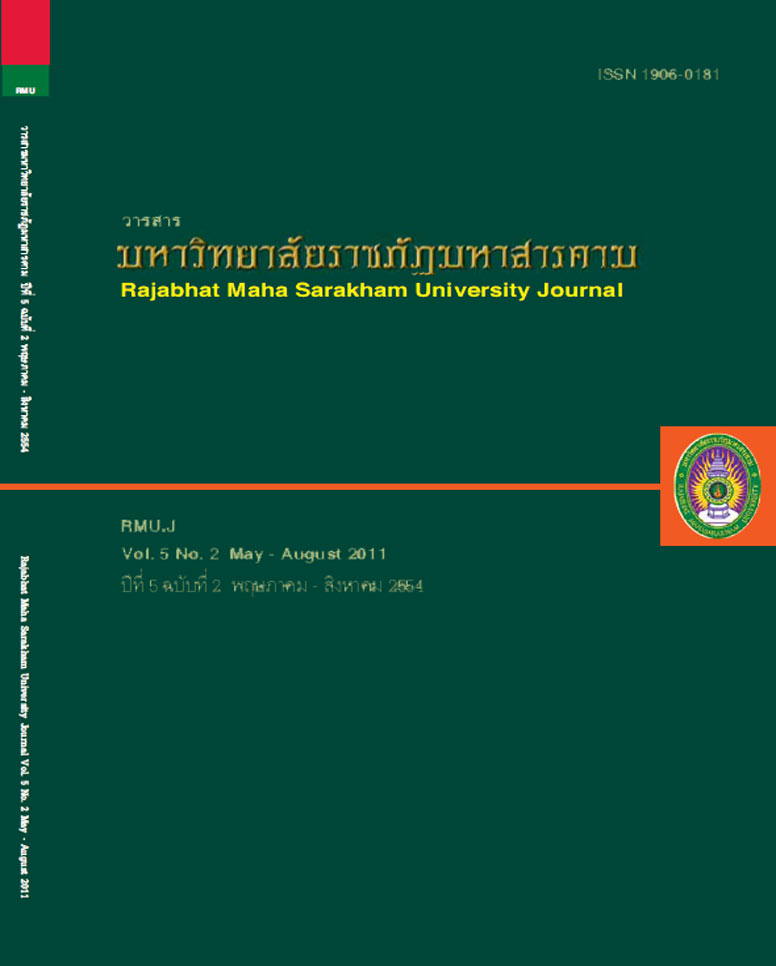การศึกษาการใช้เศษแก้วเพื่อลดต้นทุนในกระบวนการผลิตสุขภัณฑ์เซรามิกส์
Main Article Content
บทคัดย่อ
การวิจัยนี้ได้มุ่งเน้นถึงการนำเศษแก้วมาใช้ทดแทนแร่ลอย (หินฟันม้า) ในกระบวนการผลิตสุขภัณฑ์เซรามิกส์ โดยมุ่งหวังให้ต้นทุนการผลิตมีมูลค่าตํ่าลง ตัวแปรที่นำมาใช้ศึกษาถึงการปรับปรุงส่วนผสม ได้แก่ ปริมาณเศษแก้วและอุณหภูมิที่ใช้เผาได้แก่ 1,180 ํC และ 1,200 ํC รวมถึงระยะเวลาการเผา ทั้งนี้คุณสมบัติทางกลและทางกายภาพของผลิตภัณฑ์ยังคงเทียบเท่าเดิมและ/หรือดีขึ้นกว่าวัตถุดิบที่ใช้ในกระบวนการผลิตปัจจุบัน ดัชนีที่ใช้ชี้วัดถึงการลดลงของต้นทุนการผลิตพิจารณาจากมูลค่า
ปัจจุบันสุทธิ (NPV) อัตราผลตอบแทนภายในโครงการ (IRR) อัตราผลตอบแทนขั้นตํ่าสุด (MARR) และอัตราผลประโยชน์ต่อต้นทุน (B/C) โดยกำหนดให้โครงการมีอายุ 10 ปี ผลการศึกษาพบว่า
สุขภัณฑ์ที่เผา ณ อุณหภูมิ 1,200 ํC จะได้ผลิตภัณฑ์ที่มีคุณสมบัติตามเกณฑ์มาตรฐานผลิตภัณฑ์อุตสาหกรรม กล่าวคือมีการหดตัวร้อยละ 12.16 มีการดูดซึมนํ้าร้อยละ 0.30 มีค่าโมดูลัสแตกร้าว 38.87 เมกะ ปาสคัลและลักษณะผิวเคลือบไม่มีการรานตัว สีขาวมันวาว มีตำหนิรูฟองอากาศเล็กน้อยและมีคุณสมบัติใกล้เคียงกับสุขภัณฑ์ของบริษัทขอนแก่นเซรามิกส์ที่เผา
ณ อุณหภูมิ 1,230 ํC มากกว่าสุขภัณฑ์ที่เผา ณ อุณหภูมิ 1,180 ํC สามารถลดต้นทุนค่าวัตถุดิบและเชื้อเพลิงได้ 622,188.88บาท/ปี โดยมีต้นทุนในการผลิตเศษแก้ว 408,197.85 บาท/ปี เมื่อวิเคราะห์ความคุ้มค่าทางเศรษฐศาสตร์พบว่ามูลค่าปัจจุบันสุทธิ
มีค่าเท่ากับ 1,069,469.25 บาท อัตราผลตอบแทนภายในเท่ากับ 45.97% สูงกว่าอัตราผลตอบแทนขั้นตํ่าสุดซึ่งมีค่าเท่ากับ 10%ต่อปีและอัตราส่วนผลตอบแทนต่อต้นทุนมีค่ามากกว่า 1 เท่ากับ 1.39 ซึ่งมีความคุ้มค่าต่อการลงทุน เมื่อพิจารณาถึงการวิเคราะห์ความไวพบว่าการนำเศษแก้วเพื่อมาใช้ในกระบวนการผลิตสุขภัณฑ์จะให้ผลตอบแทนที่ไม่คุ้มค่า หากราคาเศษแก้วเพิ่มขึ้นสูงกว่า 2.10 บาท/กิโลกรัม
This thesis focused on the utilization of cullet for reducing the production cost of sanitary ware. The
main paratmeters were firing temperature and cullet. The firing temperatures of 1,180°C and 1200°C and firing duration were used for the study. The final products should have the same or more physical and
mechanical properties regarding the current production process. Net Present Value (NPV), Internal Rate
of Return (IRR), Minimum Attractive Rate of Return (MARR) and Benefit - Cost Ratio (B/C) were used as
indicators for the production cost.
The results showed that the properties of sanitary ware burnt at 1,200°C were in the standardized
criteria of sanitary ware products. The values of shrinkage, water absorption and Modulus were 12.16%,
.30 and 38.87 M respectively. The sanitary ware was glossy white with small hole bubbles on the surface.
The finding showed that the properties of sanitary ware were similar to sanitary ware of Khon kaen Ceramic
Company that was burnt at 1,230°C than 1,180°C. The results also indicated that the cost of raw materials
and energy was saved about 622,188.88 baht per year, which about 408,197.85 baht a year for the cullet.
Regarding the economical analysis, it revealed that the Net Present Value was 1,069,469.25 baht, the
Internal Rate of Return was 45.97% which was higher than the Minimum Attractive Rate of Return (10%),
and Benefit Cost Ratio was 1.39. Regarding the finding, it is concluded that the utilization of cullet will be
very useful and good for sanitary ware production if the price of cullet is lower than 2.10 baht per kilogram.
Article Details
1. บทความที่ลงตีพิมพ์ทุกเรื่องได้รับการตรวจทางวิชาการโดยผู้ประเมินอิสระ ผู้ทรงคุณวุฒิ (Peer Review) สาขาที่เกี่ยวข้อง อย่างน้อย 3 ท่าน ในรูปแบบ Double blind review
2. ข้อคิดเห็นใด ๆ ของบทความที่ลงตีพิมพ์ในวารสารมหาวิทยาลัยราชภัฏมหาสารคาม นี้เป็นของผู้เขียน คณะผู้จัดทำวารสารไม่จำเป็นต้องเห็นด้วย
3. กองบรรณาธิการวารสารมหาวิทยาลัยราชภัฏมหาสารคาม ไม่สงวนสิทธิ์การคัดลอกแต่ให้อ้างอิงแสดงที่มา


